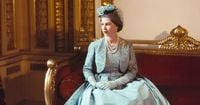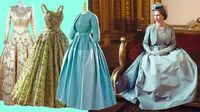When Queen Elizabeth II stepped into the public eye, she did so with a wardrobe that spoke volumes. Her clothing was never just about fashion—it was a language, a statement, and sometimes, a subtle act of diplomacy. Now, in a landmark event set for 2026, Buckingham Palace will open its doors to the largest-ever exhibition dedicated to the late monarch’s sartorial legacy, marking the centenary of her birth with a showcase that promises to be as vibrant and storied as the Queen herself.
The exhibition, titled Queen Elizabeth II: Her Life In Style, will run at The King’s Gallery in Buckingham Palace from April 10 to October 18, 2026, coinciding with what would have been Her Majesty’s 100th birthday on April 21. According to the Royal Collection, the display will feature approximately 200 items from the Queen’s wardrobe, with about half of them never before seen by the public. Tickets for this highly anticipated event are scheduled to go on sale on November 4, 2025, giving royal watchers and fashion enthusiasts alike plenty of time to prepare for what promises to be a historic occasion.
Queen Elizabeth II’s fashion sense has long been the subject of fascination and respect. Her signature look—monochromatic coats with matching hats, silk scarves, strings of pearls, Fulton umbrellas, and boxy handbags—became a visual shorthand for duty, tradition, and approachability. Robin Janvrin, her former Private Secretary, told BBC Culture, “I have always been struck by the Queen’s very practical approach to what she wears. She dresses to stand out so that people can see her – bright colours and a hat, with gloves useful when being handed all sorts of things on walkabouts.”
This practicality never meant monotony. As Elizabeth Holmes, author of HRH: So Many Thoughts on Royal Style, observed, “the Queen has very much approached her clothing as a uniform, but she keeps it creative and interesting within those guidelines.” Each outfit was crafted with intent—sometimes diplomatic, sometimes deeply personal. From bold, crowd-pleasing colors to subtle nods to her hosts, the Queen’s wardrobe was a living archive of her reign and Britain’s evolving identity.
The architects behind this royal elegance included legendary British designers Norman Hartnell, Hardy Amies, Stewart Parvin, and Angela Kelly. Angela Kelly, who served as her dresser and confidante, wrote in her memoir The Other Side of the Coin, “Our role as her dressers is to ensure that Her Majesty is appropriately attired for each occasion.” Kelly’s meticulous process included testing fabrics under various lights and fans to guarantee perfection in every setting—a testament to the precision demanded by royal life.
Throughout her reign, Queen Elizabeth II’s clothing evolved to reflect the times while maintaining a clear sense of continuity. In 1947, as a young princess, she famously used ration coupons to purchase the material for her wedding dress, a gesture of solidarity with post-war Britain. Designed by Norman Hartnell, the gown—crafted from ivory silk and duchess satin with a 15-foot train—remains an iconic symbol of resilience and hope. The exhibition will feature this legendary dress, alongside her coronation gown, both designed by Hartnell.
The 1960s saw the Queen navigating the era’s shifting fashion landscape with remarkable poise. Her hems rose slightly, her silhouettes became more structured, and she embraced bright colors like tomato red, cerulean blue, and daffodil yellow—choices that helped her stand out, especially as television transitioned to color. Only once did she officially wear trousers during an engagement, a decision she did not repeat. While her sister Princess Margaret flirted with avant-garde styles, Elizabeth remained a steadfast symbol of tradition and stability.
Every outfit told a story. During President Donald Trump’s 2018 visit, the Queen’s brooch choices—each with its own history and significance—sparked widespread commentary. And in 2020, as the world grappled with the Covid-19 pandemic, she wore a turquoise brooch symbolizing protection and hope during a televised address, offering comfort to a nation in crisis. Off duty, she leaned into her country heritage with Barbour jackets, tweed skirts, and the ever-present pearls gifted by her father, King George VI.
The upcoming exhibition will not just revisit these well-known moments but also reveal the depth and breadth of the Queen’s personal style. Highlights will include a tulle bridesmaid dress worn by Princess Elizabeth at eight years old in 1934, an apple-green evening gown designed by Hartnell for a 1957 state banquet with President Eisenhower, and a pastel blue gown worn at Princess Margaret’s wedding in 1960. There will also be practical, tailored pieces from her private wardrobe—riding clothes, Harris tweed jackets, raincoats, and headscarves—alongside design sketches and fabric samples annotated by designers and the Queen herself. One particularly striking item is a clear plastic raincoat by Hardy Amies from the 1960s, designed to keep the Queen visible to crowds even in the rain.
To underscore her influence on contemporary fashion, the exhibition will feature pieces by leading British designers Erdem Moralioglu, Richard Quinn, and Christopher Kane, all of whom have drawn inspiration from the Queen’s legacy. Moralioglu remarked, “The wardrobe of Her late Majesty is a snapshot of a very long life, a life of duty, and in so many ways it’s a time capsule. It captures a very specific and important moment in history.” Richard Quinn, recipient of the inaugural Queen Elizabeth II Award for British Design, said, “There is no doubt that Queen Elizabeth II’s style and promotion of British couture over the 90 years had a huge impact on British fashion. The ultimate stamp of approval, she always shone a light on British designers, highlighting the relevance and significance of British fashion across the world.”
Christopher Kane added, “Queen Elizabeth II’s wardrobe is one of the most significant living archives in modern fashion history. From the decline of the court dressmaker to the rise of couturiers like Hartnell and Hardy Amies, her garments tell the story of Britain and its changing identity through fashion. For designers and students, it offers a masterclass in silhouette, construction, repetition, symbolism and, perhaps most importantly, restraint.”
The exhibition’s significance is further amplified by an official centenary publication, Queen Elizabeth II: Fashion And Style, which will feature insights from the contributing designers and a tribute by Dame Anna Wintour, the global editorial director of US Vogue. The Queen’s fashion archive is now recognized as one of the largest and most important surviving collections of 20th-century British fashion, forming a key part of the Royal Collection.
For visitors, Queen Elizabeth II: Her Life In Style promises more than a glimpse into the wardrobe of a monarch. It offers a sweeping view of a nation’s history, seen through the fabrics, colors, and silhouettes that defined an era—and a Queen who understood the power of appearance like few others in history.






